News & Stories
Twitter 101 for brands
 On Twitter, Starbucks has more than 2.5 million followers. Whole Foods, more than 2.6 million. What more could a brand ask for?
On Twitter, Starbucks has more than 2.5 million followers. Whole Foods, more than 2.6 million. What more could a brand ask for?
Plenty. Getting followers is like enticing people to walk into your store. But what most brands want is the Twitter equivalent of a purchase — a retweet (when followers spread your message to their own network).
“The real power of social media for brands,” says Arvind Malhotra, T.W. Lewis Scholar and professor of strategy and entrepreneurship at UNC Kenan-Flagler, “is that their followers can validate the brand by retweeting the brand’s message to potentially thousands of people in their own personal network. This is electronic word-of-mouth at its best.”
Malhotra teamed up with his wife, Claudia Kubowicz Malhotra, associate professor of marketing at UNC Kenan-Flagler, and Alan See, CMO and vice president of MindLeaders, to find out which tweets are more likely to get those coveted retweets and why.
They created a comprehensive list of 47 big brands that use Twitter heavily. Then they collected a random sample of tweets from these brands over a few months and coded each tweet manually, based on content. Between the two of them, the Malhotras spent about 200 hours collecting data and comparing the characteristics of tweets that were retweeted most often.
“We thought it was very important to do the coding manually, because language is so nuanced, we wanted to be sure we captured and coded every informational aspect of a tweet,” Kubowicz Malhotra says.
They published the resulting tips for getting retweeted in the MIT Sloan Management Review. While the Malhotras aimed their tips at brand managers, anyone who tweets could benefit from them. A sampling:
- Keep it short. While the maximum tweet length is 140 characters, those that are even shorter — 70 characters or less — were retweeted nearly twice as often as longer tweets. Short tweets leave room for followers to add their own comments. “The retweeter is adding some support or validation — true advocacy. Allowing space for that is critical,” Claudia says.
- Show your socially responsible side. Tweets highlighting social causes were more likely to be retweeted than the average tweet. “It’s all about giving your individual followers a reason to spread the word about your brand,” Malhotra says. “I may follow Kraft on Twitter, but I don’t have to announce that. But I will retweet their message if it’s about a common cause that we both care about, such as breast cancer awareness.”
- Ask for the retweet. That may seem pushy, but it’s effective, within reason. “Be strategic. You can’t ask that every message you send out be retweeted,” Kubowicz Malhotra says. A good time to ask for retweets is when your message provides a benefit to the user, such as a discount, or requires some action, such as participating in a social cause, says Malhotra.
- Combine strategies. Tweets that use more than one of these tips simultaneously may be the most effective. For example, Starbucks tweeted about a promotion that offered to fill customers’ reusable cups with coffee for free on Earth Day. That one tweet combined three strategies: capitalizing on a current event, highlighting a social cause and offering a deal.
Follow the Malhotras @claudiakm and @arvmalhotra.